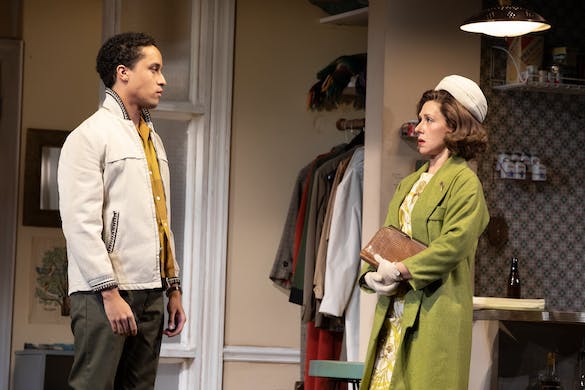From the Mind That Gave Us ‘A Raisin in the Sun,’ a Slice of the ’60s
If ‘The Sign in Sidney Brustein’s Window’ isn’t as neatly crafted a gem as the earlier drama that put Lorraine Hansberry on the map, its sobering insights, humor, and enormous, throbbing heart still provide a riveting experience.

In 1964, one of the era’s most promising young playwrights, Lorraine Hansberry, was dying of pancreatic cancer five years after becoming the first Black writer and the fifth woman to win a New York Drama Critics Circle Award for best play, for “A Raisin in the Sun.” A piercing, rousing study of a Black family’s struggles and resilience, the play became an instant American classic.
Her follow-up, “The Sign in Sidney Brustein’s Window,” would run for about three months before closing on January 10, 1965, two days before Hansberry died at age 34. “Sign” was even more ambitious than “Raisin,” focusing on an eclectic group of bohemians trying to make their mark on a world that, as the title character would note at one point, was “about to crack right down the middle,” with the broadening civil rights movement heralding a new generation’s quest for autonomy and justice.
Reviews for “Sign” were mixed, and a consensus formed that it was something of an unfinished work, with Hansberry having been too ill to properly edit and sculpt her sweeping vision. There were revivals, with tweaks guided for a while by her ex-husband and literary executor, producer Robert Nemiroff, but none on Broadway — until last week, that is, when veteran director Anne Kauffman’s new production arrived at the James Earl Jones Theatre, fresh off a run at the Brooklyn Academy of Music.
This is not Ms. Kauffman’s first tango with “Sign”; a staging she helmed for Chicago’s Goodman Theatre in 2016 was received enthusiastically. For New York, she has recruited a pair of leading players who have both celebrity stature and substantial theater backgrounds: film star Oscar Isaac appears as Sidney, a would-be entrepreneur whose latest doomed project is a neighborhood newspaper; and Rachel Brosnahan, known to TV fans as “The Marvelous Mrs. Maisel,” is cast as his wife, Iris, a failing actress further frustrated by her husband’s often callous, condescending behavior.
Although Sidney is the central character, virtually never leaving the stage during the roughly two-and-a-half-hour play — Ms. Kauffman has likened him to a “Jewish Hamlet” — “Sign” is driven by the couple’s contentious, passionate relationships, with each other and with the other Greenwich Village denizens who make up their inner circle.
There’s the biracial Alton, whose fiery idealism is relayed with both sweetness and bite by Julian De Niro, and David, a gay playwright who is as patently lonely as he is insufferably smug, with both qualities captured in Glenn Fitzgerald’s witty, nuanced portrait.
The conflicts between these disparate seekers evolve in part from what we would now call their lived experiences, marked by racism, antisemitism, homophobia, and, in Iris’s case, misogyny. Yet if Hansberry’s play was prophetic, it also harkens movingly to a time before the undeniable kinship her characters enjoy had been eroded, by identity politics on one side of the political spectrum and equally cynical forces on the other.
Throughout “Sign,” you can sense the playwright’s beautiful mind and compassionate soul striving — messily at times, but always compellingly — to reconcile her forward-thinking morality with the disappointment and doubt that have soured her protagonist. Mr. Isaac makes this torment vivid throughout his blazing performance, whether Sidney is expounding on the futility of activism — “I have lost the pretensions of the campus revolutionary,” he scoffs early on — or trying in vain to manage the aggressive impulses that are slowly but steadily destroying his marriage.
Ms. Brosnahan deftly plays off this tortured, sometimes manic energy, which can veer at the drop of a dime into lust. Ms. Kauffman and her stars make sure that even as Sidney and Iris bait and wound each other, we never doubt their mutual love — however differently they define that love, or the priorities and goals accompanying it. In the midst of tearing each other down, they’ll suddenly begin to frolic or caress; Sidney will pick up his banjo or Iris will dance at his request. Folky period music, some of it specifically indicated in the text, adds to the sexy, lyrical vibe.
The Brusteins’s relationship stands in stark contrast to the pragmatic one Iris’s elder sister has sustained with her spouse. An impeccably dressed, casually bigoted woman played with great comic punch and understated poignance by Miriam Silverman, she comes across first as a bourgeois stereotype of complacency before revealing the complexity and hypocrisy behind her seeming contentment, albeit dangling a few other clichés in the process. (We never meet the husband.) “There are no squares, Sidney,” she informs her brother-in-law.
The closest thing this play has to a real villain, it turns out, is the man whose name appears on that titular sign: one Wally O’Hara, a local politician whom Sidney is persuaded, against his better instincts, to endorse in his fledgling paper. The picture of superficial grit, deftly painted here by Andy Grotelueschen, Wally campaigns as a reformer, though he is owned by the corrupt establishment he rails against. The discovery ravages Sidney, but does not break him; Hansberry, who died too young to be broken herself, allowed her flawed hero some redemption.
“Every time we say ‘Live and let live’ — death triumphs,” Sidney declares, confronting Wally near the end of the play. If “The Sign in Sidney Brustein’s Window” isn’t as neatly crafted a gem as the earlier drama that put Hansberry on the map, its sobering insights, humor, and enormous, throbbing heart still provide a riveting experience for anyone willing to pay attention.
Correction: Julian De Niro and Miriam Silverman are the actors in the photo accompanying this article. The actors were misidentified in an earlier version.

